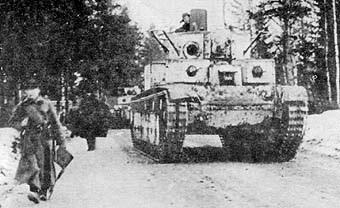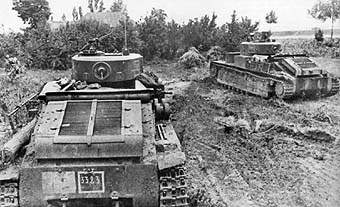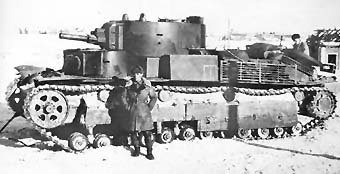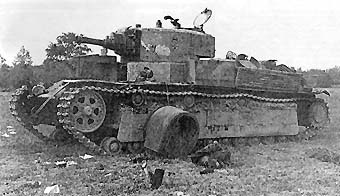The Medium T-28:

T-28 tanks on their way to the front. The Winter War. January 1940

A pair of T-28 go into action in the late summer 1941. Both vehicles are fitted with P-40 anti-aircraft machine guns mounting on the roof.

The ex-Soviet T-28e. It was captured by the Finns in 1942.

T-28 knocked out on the roadside during the fighting in Ukraine in July 1941.
The first 10 tanks were sent to the 2nd Independent Regiment of RGK of the Leningradsky military district. In fact, independent tank units of RGK were represented since 1924. The 2nd Independent Regiment was formed in 1929. Later, due to production of new T-28 tanks another four tank regiments of RGK were formed: in Smolensk, in Kiev, in Kharkov, and in Slutzk. Organization of these regiments was changed several times.
By the end of 1935, each regiment consisted of three battalions of 30 tanks (T-28 and T-35) per battalion. In December 1935 these regiments were collected into independent heavy tank brigades. In these brigades, tanks of different classes weren’t mixed with each other. In other words, a brigade might have T-28’s or T-35’s but not both types at the same time.
A heavy tank brigade of T-28’s consisted of a three common tank battalions, a training battalion, supply battalion and some other units.
This organization was created on 12 December 1935 by the order of Minister of Defense. However on 21 May 1936 all these brigades were assigned to the RGK. In 1939 there were four heavy tank brigades: the 4th, 5th 10th, and 20th tank brigades. In a deviation from the policy of matching tank types to units, the 5th tank brigade had both T-28 and T-35.
The 4th and 10th tank brigades were the first tank brigades which took part in military conflict. In September 1939 they took part in the occupation of Bessarabia (West Ukraine). After analysis of the first deployment of these brigades, ABTU ordered the reorganization of all tank brigades: now they were to consist of three tank battalions of 156 tanks per battalion (117 T-28 and 39 BT). There were also future plans to replace them with the KV-1.
On 30 November 1939 the Russo-Finnish war began (also known as the Winter War). The 10th and 20th tank brigades took part in this war. When the war ended, the 20th Brigade (commander - kombrig Borzilov) was awarded with the Red Banner Order.
During the Winter War, T-28 tanks were used first for direct gunfire on embrasures of a Finnish pillboxes. However the standard 30 mm armor couldn’t protect the tanks from Finnish AT-guns. That’s why Soviet losses of T-28’s were so high. Immediately after those battles, the T-28’s were equipped with additional armor.
During the Winter War a couple of T-28 tanks were captured by the Finns. In 1941 they’ve captured another five vehicles. Those ex-Soviet tanks served up to the end of the war in the one Finnish tank brigade. In 1944 one of those vehicles was modified (all turrets removed) and used as an armored evacuation vehicle up to 1951.
There are rumors, that in 1955 two tanks were sold to Turkey. However, not one archival document confirm that.
In March 1940, the Red Army started its new reorganization and formed several mechanized corps. Each mechanized corps consisted of two tank divisions and one motorised regiment. In that time all tank brigades were disbanded and their tanks were added to the new tank divisions. For example, on 22 June 1941, the 8th Tank Division (4th Mechanized Corps) had 75 T-28 tanks, another 5 vehicles were in 10th Tank Division (15th Mechanized Corps). Both corps were attached to the Kiev military district.
On 15 July 1941, the 16th Mechanized Corps received an order from the commander of South-West Front to make a strike on Zhitomir. The 29th Tank Regiment (15th Tank Division) took part in this battle. During a counter-attack at Semenovka (a village near Berdichev) one platoon of T-28’s under the command of 1st Lieutenant Vasiliy Sumtzov destroyed three German tanks, two AT-guns, one mortar, 7 trucks and about 100 German soldiers.
The fate of T-28 tanks was the same as for all other Soviet tanks - most them were lost in first two months of war. Some of the surviving T-28’s served up to 1943 on the Leningradskiy Front and during the Moscow counter-offensive (1941).
In the summer of 1941 the design of the T-28 became obsolete due to the drawbacks of multi-turret vehicles. German Pz-III and Pz-IV had an equal armor protection but were much more maneuverable, but the T-28 was better armed than any German tank in 1941 and could hit any German tank from long distances.
Experimental tanks had mine-clearing equipment TM-35 or equipment for crossing rivers under water T-28PKh.
http://www.battlefield.ru












